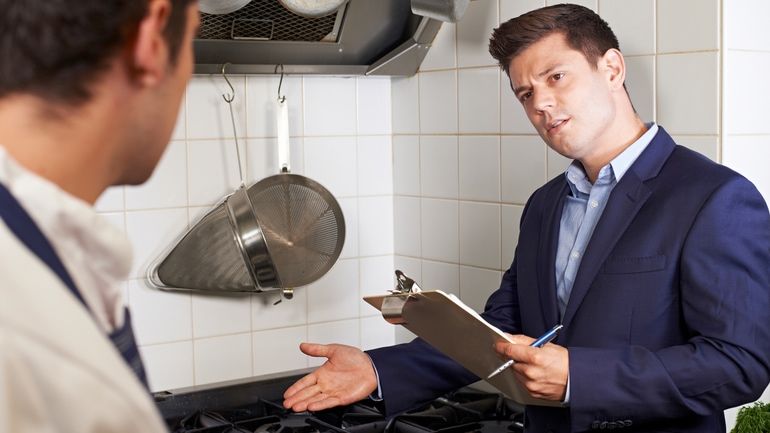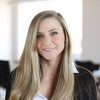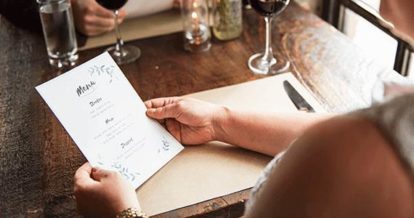Did you know that 70% of diners are deterred by health code violations when choosing a restaurant? While public health codes play an important role in keeping customers from becoming susceptible to foodborne illnesses, the results of restaurant health inspections can also make or break a business.
According to a study of Los Angeles restaurants, restaurants with an A hygiene grade had more sales than restaurants with poorer hygiene. Health code violations, therefore, affect both customer safety and restaurant success.
Customers are more concerned with and aware of restaurant hygiene and sanitation practices than ever before. In the midst of the COVID-19 pandemic, eating food made by others and dining out can be a risky activity. Restaurants need to pay even more attention to health code standards, including new COVID-related measures, to boost customer confidence in dining outside the home.
The bottom line is that strictly adhering to the health code is a must for restaurants. But how can you ensure that your restaurant is staying on top of complicated, wordy health code regulations? This guide to avoiding restaurant health code violations can help.
Keep reading to learn FAQs about restaurant health code violations, including:
- What are health code violations?
- Who creates the health code and who enforces it?
- What can you expect from a restaurant health inspection?
- How does COVID-19 affect the health code and inspections?
We’ll also go through 15 common restaurant health code violations, including traditional violations and COVID-19-related violations, and tips to avoid them.
Pay attention now – the longevity of your business and the safety of your guests depends on it!

Use this downloadable checklist to ensure your restaurant is compliant with food, health, and safety regulations.
5 FAQs About Restaurant Health Code Violations
Here’s everything you need to know about the health code, health code violations, and health code inspections.
1. What are restaurant health code violations?
A health code violation is when a restaurant fails to adhere to rules about food safety, hygiene, and/or sanitation. Health codes were created to protect the public from the spread of foodborne illnesses.
These rules are enforced by restaurant health inspections. Restaurants are fined for not adhering to the health code, and can even be shut down if they make egregious mistakes. To ensure your staff follow your health and safety protocols, consider including them in a restaurant opening and closing checklist.
2. Who creates the health code?
In the United States, the Food and Drug Administrations sets national recommendations for municipal health code guidelines in its Food Code. Since these are just recommendations, every state is responsible for creating and enforcing its own health code.
Some city governments also create stricter health codes for their restaurants and food service establishments. For example, in New York City and Seattle health inspection grades must be displayed in a restaurant’s window. While health code grades are published online in most U.S. municipalities, the window display system gives customers instant access to information about the cleanliness and safety of restaurants they dine in.
Canada has a national health code for restaurants, known as the Safe Food for Canadians Regulations. Provincial governments and municipalities may also have additional health codes, like Ontario’s Food Premise Regulation and Toronto’s DineSafe program.
3. Who enforces restaurant health codes?
The governments that determine health codes are also responsible for enforcing them through health code inspections. Restaurants are typically inspected between one to four times a year. Check local regulations to find out exactly how often you should expect a visit from a health code inspector.

4. What should I expect from a restaurant health inspection?
During a health code inspection, an inspector will come to your restaurant to look for health code violations. In some places, inspectors announce when they’ll be visiting, while in others, their arrival is a surprise.
Because you may not know when an inspector is coming, you need to make sure your restaurant is always following the health code. Familiarize yourself with your local restaurant health inspection forms to know what the inspector will be looking for.
When the inspector arrives, give them full access to the restaurant. Don’t try to hide anything, as this will cause suspicion, and in some places, can merit a hefty fine. In New York City, obstructing health code inspectors from doing their job will set you back $1,000.
At the end of the inspection, you’ll receive a grade and a report. You’ll be able to fix some violations on the spot. For more critical violations, the inspector will come back for a follow up inspection to ensure that violations have been resolved.
In most places, you’ll have to pay penalties for restaurant health code violations. In New York City for example, you can be fined $200 for improperly dispensing drinking straws, and between $250 and $600 for cross-contaminating food in storage. In Toronto, penalties range from $55 to $465 for various violations.
5. How does COVID-19 affect restaurant health inspections?
Increased safety measures have been suggested or mandated around the United States and Canada. Compliance with these rules can affect health code inspections, but it really varies from government to government.
San Diego County in California, for example, has issued COVID-19 protocol for food service establishments to follow, but doesn’t take it into consideration in health code grading. In Philadelphia, however, COVID-19 measure violations have already been factored into restaurant health inspection grades.
In places like Montreal where municipal governments haven’t added coronavirus-related measures to the health code, restaurateurs are taking it upon themselves to take extra precautions.

Download our restaurant cleaning checklist for front of house and back of house cleaning.
15 Common Restaurant Health Code Violations and How to Avoid Them
Pass your health code inspection with flying colors by avoiding these common health code violations. We’re highlighting COVID-19-related violations, as well as traditional violations.

COVID-19-Related Restaurant Health Code Violations
1. Lack of or improper use of personal protective equipment (PPE)
Ensure that all employees – front-of-house (FOH) and back-of-house (BOH) – wear PPE, like face masks, while on-premise and wear them properly. Masks should cover the nose and chin simultaneously and should have no gaps or vents. Avoid this violation by providing your staff with PPE and training them on the right way to wear it.
2. Failing to conduct employee health screenings
Some places require restaurants to do daily staff temperature and symptom checks to ensure that no one who is sick is working and potentially spreading COVID-19 to customers. Avoid this violation by conducting employee health checks and keeping records of them.
3. Exceeding capacity
Many areas have allowed restaurants to reopen contingent on operating at a reduced capacity. Avoid overcrowding by posting your new capacity limits outside and making it someone’s job to enforce capacity.

Use this downloadable checklist to ensure your restaurant is compliant with food, health, and safety regulations.
4. Indoor dining
If your area doesn’t allow indoor dining yet, your restaurant could be in big trouble for allowing it. Rather than breaking this rule, get a permit to create an outdoor dining room, or focus your efforts on takeout to maximize revenue while adhering to local regulations.
5. Improper ventilation
In places where on-premise dining is allowed, your restaurant may need to ensure proper ventilation. For patio dining, this means that you can’t use tents that prevent air from circulating. For indoor dining, this means properly maintaining your restaurant HVAC system, this means keeping windows and doors open when possible.
6. Disobeying social distancing
Facilitate social distancing by properly spacing out tables (6 feet or 2 meters apart in most places) and asking guests to queue up outside rather than wait for a table in your lobby.
7. Allowing self-service
Self-service dining like buffets, salad bars, and beverage filling stations are COVID-19 health code violations in many places. Avoid a penalty by removing self-service stations and making staff serve customers instead.

Traditional Restaurant Health Code Violations
8. Missing signs and posters
Most health codes require certain signage to be posted in the restaurant to encourage and remind staff to follow safe food handling procedures.
Avoid a violation and a fine by reading up on what signs you need around your restaurant, like the “all employees must wash hands” sign placed in your bathroom.
9. Improper handling and storage of serviceware
Your staff must handle and store plates, glasses, silverware, and straws in ways that don’t allow bacteria and other harmful things to spread from their hands to customers’ food. Both BOH and FOH teams should only handle serviceware by the rims. Glasses and plates must be stored upside down to prevent surfaces from collecting potentially harmful germs or debris.

Download our restaurant cleaning checklist for front of house and back of house cleaning.
10. Storing expired foods
If foods have passed their expiration dates or look like they’re going bad, you need to get rid of them. When a health inspector finds expired milk in your fridge, they’ll have a hard time believing that you weren’t planning to serve it to customers. Make it someone’s responsibility to check inventory regularly and dispose of suspicious items.
11. Improper food storage
The order in which you store food plays an important role in preventing foodborne illnesses. Store your food properly by stacking food in this order in the fridge. From top to bottom:
Vegetables:
- Raw vegetables on top
- Cooked vegetables below
Cooked meats:
- Meats on top
- Fish and shellfish below
Raw meats:
- Fish and shellfish on top
- Beef, pork, lamb, and veal below
- Ground meats below that
- Poultry on the bottom
This stacking order prevents dangerous fluids, like blood, from leaking from one ingredient to another and not being properly cooked to kill off bacteria. Seafood, for example, needs a minimum internal temperature of 145 °F/62.8 °C, while poultry needs to reach 165 °F/73.9 °C.
12. Improper food temperature
Storing and serving food at the wrong temperature and for too long warrants a health code violation. Avoid a penalty by establishing protocols to ensure food isn’t kept out longer than it needs to be and becoming familiar with how long perishable foods can be kept unrefrigerated. Warm items shouldn’t be kept at room temperature for longer than one hour, and cold items for two hours.
13. Poor staff hygiene
It’s important for staff to maintain strict personal hygiene measures. This may include wearing hats or hair nets, washing hands thoroughly, not coming to work when sick, keeping uniforms clean, and not touching dirty cell phones when handling food.
Training your staff on these best practices, and enforcing them, is the best way to avoid this health code violation when the inspector shows up unexpectedly.

Use this downloadable checklist to ensure your restaurant is compliant with food, health, and safety regulations.
14. Cross-contamination
Using hands, utensils, and other surfaces that touched raw food to also touch produce, cooked foods, or other types of meats is a terrific way to spread salmonella and E. coli, and get a health code violation.
Avoid cross-contamination by washing hands, utensils, and surfaces before and after handling raw and cooked meats and seafood. Use dedicated, color-coded cutting boards and utensils for separate items to avoid confusion.
15. Improper use and storage of cleaning supplies
Your restaurant is responsible for making sure eating surfaces are properly sanitized and that harmful chemicals don’t end up in customers’ bodies. Do this by using cleaning solutions that don’t just make surfaces look clean, but that effectively disinfect surfaces. Don’t forget to store cleaning solutions and supplies away from food.
Regularly brushing up on your local health code and conducting your own restaurant health inspections are the best ways to avoid dangerous and expensive restaurant health code violations. Keep your customers and staff healthy to ensure the longevity of your business.

Download our restaurant cleaning checklist for front of house and back of house cleaning.
Download our free inventory template
Sign up for our free weekly TouchBistro Newsletter







